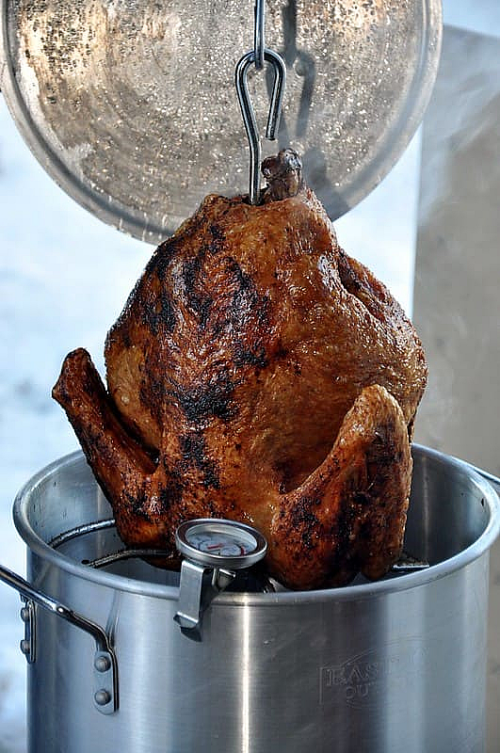It seems deep-fried turkeys are a holiday must these days. Believe it or not, the one-pot cooking method is not a new culinary sensation. It has been around for eons and got its Louisiana Cajun country roots in the late 80s and 90s.
As more and more folks fry turkeys, especially around Thanksgiving and Christmas, accounts of horrific accidents involving the process have increased as well. Every year deep-fryer fires are responsible for five deaths, 60 injuries, the destruction of 900 homes, and more than $15-million in property damage, according to the National Fire Protection Association.
Tales of houses burning down, serious hot oil burn injuries, and even explosions have occurred involving turkey frying. But if the process is done right and specific safety guidelines are followed, the end result will be a crispy, moist, and scrumptious bird.
Here are a few tips to take note of before you drop your bird in hot oil:
- A smaller bird is best. A 10-to-12-pound turkey cooks better in a fryer. A larger turkey has to cook longer, so there is a greater chance of burning the oil.
- Select a fryer large enough to submerge the turkey without it spilling over completely. The oil should cover the turkey by 1 to 2 inches.
- Never drop an unthawed turkey into a fryer’s hot oil! Partially frozen turkeys placed into a fryer can cause a spillover effect, which would result in a fire.
- Never exceed the maximum fill line of a fryer and preheat the oil according to its manufacturer’s suggestion.
- Pat your bird dry inside and out with paper towel, then prepare it as desired with dry seasonings and/or an injection of a marinade. Word to the wise–do not inject the marinade just under the skin as a water-based marinade will result in hot oil popping and splattering. Remember to remove the pop-up timer from the breast (if applicable).
- Do not stuff your turkey with dressing!
- Propane turkey fryers must be used outdoors and placed on level dirt or grassy area. Never place a propane unit on a wooden deck or on concrete, which can be stained by the splattering oil.
- Never plop a turkey into hot oil; slowly and carefully lower it to prevent splattering. Be sure to use long oven mitts on your hands and sport long sleeves to rduce the risk off skin burns.
- It’s best to use an oil that is low in saturated fat, as the turkey will only absorb a small amount of it as it cooks. Peanut oil is one good option for deep-frying turkeys because its high flash point makes it less likely to catch fire.
- According to the Texas Peanut Producers Board, peanut oil may be used three or four times to fry turkeys before signs of deterioration begin. Indications that the oil needs to be discarded include foaming, darkening, or smoking excessively, indicating the oil must be discarded. Other signs of deteriorated oil include a rancid smell and/or failure to bubble when food is added.
- Once you’re done frying your bird, remove it from the fryer and place it on a sturdy tray lined with paper towels. The turkey’s internal temperature should be 165°F to 170°F in the breast and 175°F to 180°F in the thigh.
- Once finished, carefully remove the pot from the burner, place it on a level surface, and cover to let the oil cool overnight before disposing of it.
- One last tip–Keep a watchful eye on your fryer. NEVER leave it unattended during the heating, cooking, and cooling process! Always have an “ABC” or grease-rated fire extinguisher handy just in case. NEVER use water or a garden hose if your turkey fryer catches on fire.











